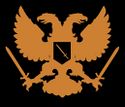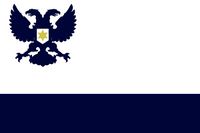Difference between revisions of "Propaganda in Pavulturilor"
| Line 57: | Line 57: | ||
[[File:Du-le Lupta!.png|200px|left|thumb|The famous "Du-le Lupta" poster from February 1948]] | [[File:Du-le Lupta!.png|200px|left|thumb|The famous "Du-le Lupta" poster from February 1948]] | ||
| − | ==See | + | ==See Also== |
* [[Propaganda in Creeperopolis]] | * [[Propaganda in Creeperopolis]] | ||
Revision as of 07:33, 10 May 2024
| Part of a series on |
| Cohenism |
|---|
 Pavulturilori War Eagle |
Propaganda has been used in Pavulturilor since the Second Călăneasan War in the mid 1880's however, it has only been widespread since the South Ecros War from 1945. Propaganda today is used by the Pavulturilori government to justify its authority, programs, and encourage popular support for the Party for National Integrity and Military.
Use
Second Călăneasan War
During the Second Călăneasan War, propaganda often depicted soldiers of the Royal Pavulturilori Army as Dacian Lancers battling against staveing Illyrian peseants[note 1].
Creeperian Civil War
During the Creeperian Civil War, the Kingdom of Pavulturilor sent a volunteer force to the aid of the Imperial Catholic Restoration Council, this intervention would be justified by propaganda depicting both monarchies as friendly towards one another, sharing many common intrests such as fighting against Islamism and against Communism.
South Ecros War
During the South Ecros War, propaganda in Pavulturilor delt in 2 main fronts, the Alaian Front and the Călăneasan Front.
Alaian Front
Since the start of the South Ecros War, Alaia has been depicted as an inseperable part of Pavulturilor, due to region's Jewish history, and with the Terranilian control of the region being depicted as a historical wrong that needs to be corrected, this depiction would last through the Alaia Wars to the modern day, with sayings such as "Două bănci pentru Alaya, ambele noastre!"[note 2], "Alaia este Pavulturilor!", and "Încheiați pragul Vaktrian!" being popular cachphrases of Pavulturilori propaganda to this day.
Călăneasan Offensive
Following the Illyrian Invasion of Călăneasa, The South Ecros War was depicted in Pavulturilor as a war of extermination with New Illyricum depicted as an often brutish character that wants to destory the Pavulturilo people and culture, while the Royal Armed Forces of Pavulturilor being depicted as valiant defenders of the country, the motif of Dacian Lancers from the propaganda of the Second Călăneasan War saw a return, while the phrase "Du-le Lupta"[note 3] was popularized, espacially after the initial success of the 1948 Counter Offensive.
Khermon War
In the years leading up to the Khermon War, New Illyricum was depicted an aggresive and villianous due to its Annexation of The Eisley in 1956, eventually culminating in the Khermon War of 1959 to 1961, during the years of the conflict the Khermon Mountain Range was depicted as an impenetrable fortress with propaganda often mocking the New Illyrian Armed Forces and their assaults on the mountain range with insulting questions such as "Câte cadavre mai multe?"[note 4] and "Până când vei continua să mori?"[note 5] often written on pictures of the mountains.
Alaia Wars
During the Alaia Wars, propaganda depictions of Terranihil ranging from an evil beast or a pathetic and crippled one attempting to resist and prosecute Alaia's jewish population, and of Pavulturilor as their defender, as well as irrdentist claims about Alaia, these themes would hardly be changed throught the course of these wars and skirmishes.
Judea Crisis
During the Judea Crisis, Pavulturilori propagandists depicted the Islamic Republic of Sconia as a demonic beast with devilish horns and tails, and sharp teeth and claws, often with the latter aimed at Dăbuza, while Pavulturilor was depicted as a Templar Knight either blocking it with his shield or slaying it with his sword, as the war progressed, depictions of Creeperian Crusader knights became incisibly common in conjunction often depicting the two as allies, with a popular return of Creeperian Civil War era porpaganda posters, other nations that have provided Pavulturilor with aid, such as Montcrabe and Paleocacher were also depicted in an especially positive light, while nations that have priviously supported Sconia, such as Ajakanistan and Zloveshchiy being depicted in the same spirit as sconia itself.
Dubătemir Insurgency
Following The Midnight Affairs, the depiction of Communism in propaganda, which was already quite negative, took an especially sharp turn, while attempts from the Pavulturilori People's Army were unsuccessful at gaining support, while governemnt were much more successful nation-wide.
2020's
Doctrine
Themes
Knights
Irrdensitm
Foreign relations
CODECO
CODECO countries are often depicted in a positive light, with Creeperopolis, Montcrabe especially regarded as some of Pavulturilor's closest allies.
ACES
Meanwhile, core ACES countries as mostly depicted in a negative light, with two notable exceptions being Majocco and Montesyette, the former for having a major jewish pupulation that is well treated, and the latter for sending aid during the Judea Crisis. However, most of the Global ACES countries, such as Monsilva, Gjorka and Paleocacher Are considered in the same vain as Creeperopolis and Montcrabe.
Communist countries
Communist countries, and Communism as a whole, are protrayed negativly in propaganda with the only execption being propaganda originating from the Pavulturilori People's Army, with depictions ranging from wild beasts and sinsiter animals, to frail and pathetic corpse-like protrails of hordes of either starving near-dead people, or outright living-dead and reanimated corpses.
Media
Gallery
See Also
Notes
- ↑ some historians have argued that this was the first recoded instance of Anti-Communism in Pavulturilor, though a bit indirect, they justify this by the depiction of New Illyricum as a nation where most people are starving, as a description of its communist system
- ↑ "[There are] Two banks to Alaia, Both are ours!"
- ↑ "Take the Fight to Them"
- ↑ "How many more corpses?"
- ↑ "Until when will you keep dying?"

